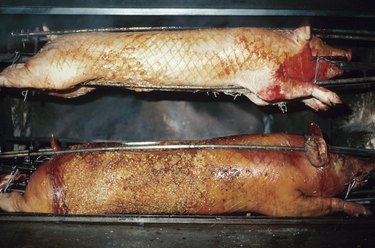
Rotisserie grilling consists of placing food on a spit rod and slowly rotating it over a fire. This type of grilling is primarily used for large and small pieces of meat, but can also be used for cooking vegetables. While rotisserie grilling, the right rotating speed is essential for cooking the food properly. Rotisserie grilling is advantageous since it does not leave any unwanted grill marks on the food and barbecue chefs let the spit do all the work.
Rotisserie Motor
Video of the Day
The rotisserie motor is an electric mechanism responsible for turning the spit rod. Rotisserie motors measure their rotating speeds in terms of revolutions per minute. A revolution per minute is how often the spit rotates within a minute. Before the advent of electric rotisserie motors, the spit was turned manually via a crank.
Video of the Day
Large vs. Smaller Meats
The appropriate rotating speed for cooking rotisserie style largely depends on how much meat is on the spit or within a rotisserie basket. When cooking small amounts of meat, set the rotisserie motor to around 4 to 6 RPMs. Examples of smaller meat are chicken breasts, ribs, beef slices and sausages. Larger, thick pieces of meat require a slower rotating speed, such as 1 to 3 RPMs. Whole pigs and roasts are larger pieces of meat.
Placement
Even if they are set at the right rotating speed, pieces of meat burn or crisp if they are not properly set on the spit. Make sure the meat is centered and balanced on the spit for the most effective cooking. Truss whole turkey and chickens with butcher's twine to avoid meat from burning or crisping. Trussing is tying up the wings and legs of chicken and turkeys to prevent them from flopping down while cooking. Trim any excess trussing string with scissors.
Indirect Heating
Use indirect heating when rotisserie grilling in a charcoal or gas grill. Charcoal grills provide heat by lighting charcoal briquets on fire, while gas grills utilize natural gas or propane to start flames. Indirect heating requires setting the spit and food apart from the grill's fire. The rotating speeds for rotisserie grilling in charcoal and gas grills are the same as other types of grills. More time is necessary for cooking in a charcoal grill. Add fresh charcoal every 30 to 40 minutes to properly heat the food. It is easier to center and balance food on spits in gas grills with front and rear burners. For side-burner gas grills, set the burners on low and place a drip pan over the burners to avoid damaging the food.